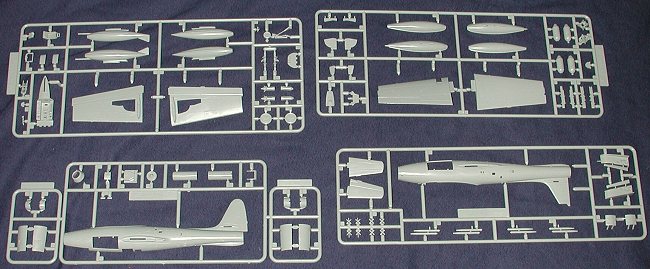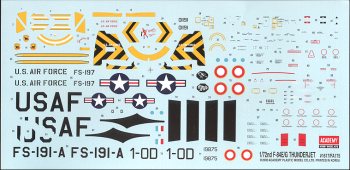
|
KIT: |
Academy 1/72 F-84E/G |
|
KIT # |
1617 |
|
PRICE: |
$14.00 |
|
DECALS: |
Three aircraft |
|
REVIEW & |
|
|
NOTES: |

|
HISTORY |
Initially designed as an escort fighter, the F-84 soon found itself embroiled in the Korean War as a fighter bomber. Though it was able to knock down a Mig or two during the conflict, it was its ability to put ordnance where it was needed that made the Thunderjet's reputation. Only two variants of the Thunderjet were in service in Korea; the F-84E and later in the war, it was joined by the nuclear capable F-84G. Both were later being replaced by the F-86F when the cease-fire was signed in 1953.
|
THE KIT |

When the Academy kit first appeared, there was much talk of this being a Tamiya knock-off. Frankly, nothing could be farther from the truth. This is a wholly new kit that is similar to the Tamiya version only in that it is an F-84. The box top intimates that it can also be built as an F-84E, and there are different tail exhaust sections to take care of the major differences between the two.
The molding is really super with nicely engraved panel lines and well detailed interior and wheel wells. There are some ejector pin marks on the interior of the exhaust and speed brake, neither of which will be simple to remove should you decide to do so. Very much like a Monogram/ProModeler kit, the nose gear doors are molded with the nose wheel well/intake assembly. Personally, I don't like that arrangement, but there it is.
Other bits available to make it an E or G are a section for the blow by doors in the nose, inserts for the refueling door on the leading edge of the wing, a different canopy without the framework (not shown), and, though this is not E/G specific, there are boom refueling probes on the tip tanks which can be removed if desired. For things under wings you have drop tanks, bombs and rockets. You also get a choice of early or late speed brakes. One set is perforated and the other has four large square indentations. You'll find these quite handy if doing a NATO Thunderjet as most did not have the perforated brake.
 Instructions are more than
adequate with several construction steps and notes outlining the variations when
needed. Colors are given in FS standard when needed. There are decals for three
different aircraft. First is the box art aircraft, an F-84Eof the 8th FBS in
Korea. As with the two G models, it has been retrofitted with the framed canopy.
Next is an F84G of the 8th FBS post war in 1955. Finally a French F-84G, though
the unit is not given. This scheme is very similar to one offered in the Heller
F-84G kit. If you don't like any of those, there are a number of aftermarket
sheets that can supply you with alternates. The sheet itself is rather large and
most complete. I've had good luck with Academy sheets though others have
complained about needing industrial strength setting solution to get them to
work.
Instructions are more than
adequate with several construction steps and notes outlining the variations when
needed. Colors are given in FS standard when needed. There are decals for three
different aircraft. First is the box art aircraft, an F-84Eof the 8th FBS in
Korea. As with the two G models, it has been retrofitted with the framed canopy.
Next is an F84G of the 8th FBS post war in 1955. Finally a French F-84G, though
the unit is not given. This scheme is very similar to one offered in the Heller
F-84G kit. If you don't like any of those, there are a number of aftermarket
sheets that can supply you with alternates. The sheet itself is rather large and
most complete. I've had good luck with Academy sheets though others have
complained about needing industrial strength setting solution to get them to
work.
|
CONCLUSIONS |
Now that Tamiya has lowered their F-84G price to near that of the Academy kit, it seems to be a real toss up as to which to buy. This one seems a bit more fiddly, but offers an F-84E version as well as underwing rockets that the Tamiya kit does not. My Academy F-84G also came with a display stand that isn't offered by too many kits nowadays. The test will be in the building.
Review kit courtesy of me and my wallet!
If you would like your product reviewed fairly and quickly by a site that has over 100,000 visits a month, please contact me or see other details in the Note to Contributors.